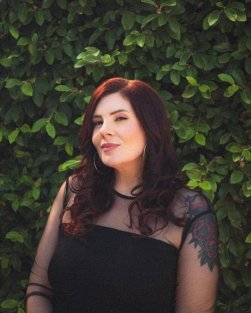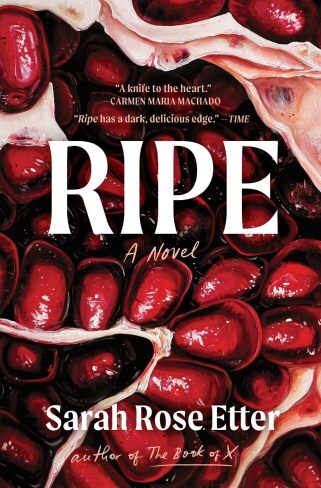Surrealism and Sub-Genres: An Interview with Sarah Rose Etter

One of the biggest joys of being a bookseller (and there are many), is getting to spend my days gushing to customers about my favorite books. Perhaps my favorite type of book to pitch to customers are the ones with out-of-the-box, absurdist premises — the books that, upon hearing the plot synopsis, gets people to squint their eyes and tilt their head to the side a little bit. These books are my favorite to pitch because, if I’m doing my job well, I’m able to overcome that initial perplexed reaction and get the customer to see why this book has me so excited, and then they walk away just as excited about it as I am.
As soon as I started reading Sarah Rose Etter’s latest novel, Ripe, I knew it was going to be one of those books. In it, we follow Cassie as she struggles in a demanding and demoralizing Silicon Valley tech job and goes through her days constantly accompanied by a floating black hole that follows her at all times. (This is about the part in the conversation where I’d expect you to give me that squinty-eye look.)
Ripe is brilliantly intriguing from the very first page. It is smart, it is poignant, and in the best way possible, it is weird. It was a great joy for me to be able to ask Sarah some questions about this novel; I hope you all enjoy this interview with her!
— Maddie Grimes, Parnassus bookseller
 Sarah Rose Etter | Photo by Lee Jameson
Sarah Rose Etter | Photo by Lee JamesonMaddie Grimes: In my mind, Ripe falls into my favorite sub-genre, what I refer to as “unhinged women’s fiction.” With books like yours, and other authors like Mona Awad and Ottessa Moshfegh, what is it about using imagery that is bizarre or grotesque that lets you tell your story in a way that realistic fiction or a more straight-forward narrative would not?
Sarah Rose Etter: For me, the surrealism is a place for the reader to meet me in a new way. The black hole in Ripe might represent grief to me, depression to the main character Cassie, and something entirely different, like anxiety, to the reader. I always want to leave some space for the reader to project onto so the book takes on another dimension. It’s also a way of taking these universal feelings — like grief and love and despair — and putting them in a new context so we might look at them in a different way, or find a new way to understand each other. A lot of this is what makes surrealism so effective in visual art, too — you have the artist’s intent, sure, but that’s almost secondary to the experience of the viewer and their interpretation.
MG: I’m super interested to know about the early developmental stages of crafting this novel. When you thought of the idea for Ripe, did you always know your main character would have a black hole companion When did that particular idea strike, and how did you land on it?
SRE: I wrote this novel shortly after my father died suddenly of a heart attack and we went into COVID lockdown. So it really is the product of so much grief and so much loneliness and uncertainty about the future. The black hole, for me, became an obsession because I wanted to understand my grief, and I wanted to understand life and death. So I found myself really drawn to black holes, whether as a portal to another dimension or as a path to obliteration. They really work as a metaphor for death — they suggest an afterlife or nothing at all comes after this. And that obsession just bled into the book.
MG: I enjoyed every moment I spent reading Ripe, and a big part of that was the unique way you formatted each chapter to begin with its own dictionary-like definition. For me, it added a perfect element of fun and whimsy into a story that was, for the most part, strikingly heavy. Did this structure change anything about your writing process?
SRE: Chalk that up to my writer OCD — everything in a novel needs to be structured and balanced or I go a little insane. The definitions really started as a way to try to mirror the way we remember things — how if we hear a certain song or smell a certain cologne, we might get immediately transported back into a memory. I wanted a way to recreate that in the text — it was a way to give Cassie enough backstory without being boring, I hope, but it also helped me structure the story as I was writing it.
MG: Like your main character, you’ve worked in Silicon Valley. How much of Cassie’s experiences (both professional and black-hole related) are based on your own life?
SRE: There’s a really great bit in Is Mother Dead by Vidgis Hjorth that I feel very tied to –
“The relationship of a work of art to reality is uninteresting, the work’s relationship to the truth is crucial; the true value of the work doesn’t lie in its relationship to a so-called reality, but in its effect on the observer.”
This has been such a helpful way of thinking about Ripe — there is a piece of my life in all of my work, but I think it’s much more important that the book be true than real. And I do think the book is true, in that sense.
MG: Talk about a cover! I know every book’s publishing process is unique, so how much input did you get to have in your cover design, and how did you end up lucking out so hard with the cover of my absolute dreams?
SRE: I got really lucky with this cover — the team at Scribner has always understood this novel and they didn’t try to soften it up at all. As we went through ideas for cover art, I’d sent over a ton of the artwork I’d looked at as I was writing Ripe, and they plucked this image out of the bunch. As soon as I saw it paired with that font, I knew we were cooking, honey! I fell in love with Angela Faustina’s work during COVID while I was writing the book so it feels very kismet that it ended up on the cover.
MG: During your drafting process, were you reading any other books or consuming any media that you found to be helpful creative inspiration? How much of your writing is inspired by other art and how much is inspired by real-life encounters?
SRE: I was definitely reading the unhinged girl classics – The Bell Jar, Play It As It Lays, Problems by Jade Sharma. I was also watching I May Destroy You a lot — I felt so drawn to the structure, how it wasn’t afraid to be bleak, the multiple endings. It just felt exquisitely done. I was really obsessed with that show.
In terms of visual art, I was definitely watching The Color of Pomegranates, which is incredible. But I also spent a lot of time digging through the online archives of the museums, looking for pomegranate and black hole artwork when I wasn’t writing.
MG: We always like to finish up with this question: What is your favorite thing about independent bookstores?
SRE: I honestly wouldn’t have a career without indie bookstores and indie booksellers. Without their dedication to my work, I never would have made it anywhere. I know this is going to sound dramatic, but I genuinely believe indie bookstores sort of saved my life. If they hadn’t been so passionate about selling The Book of X, I never would have gotten an agent or worked on Ripe during the hardest time in my life. And Ripe was a project that kept me going when I was at such a low point. All of that to say, indie bookstores and booksellers are the one of the biggest reasons I can keep writing books. I love y’all.
Ripe is on our shelves now! Grab a copy in-store or online.
Ann Patchett's Blog
- Ann Patchett's profile
- 27422 followers




